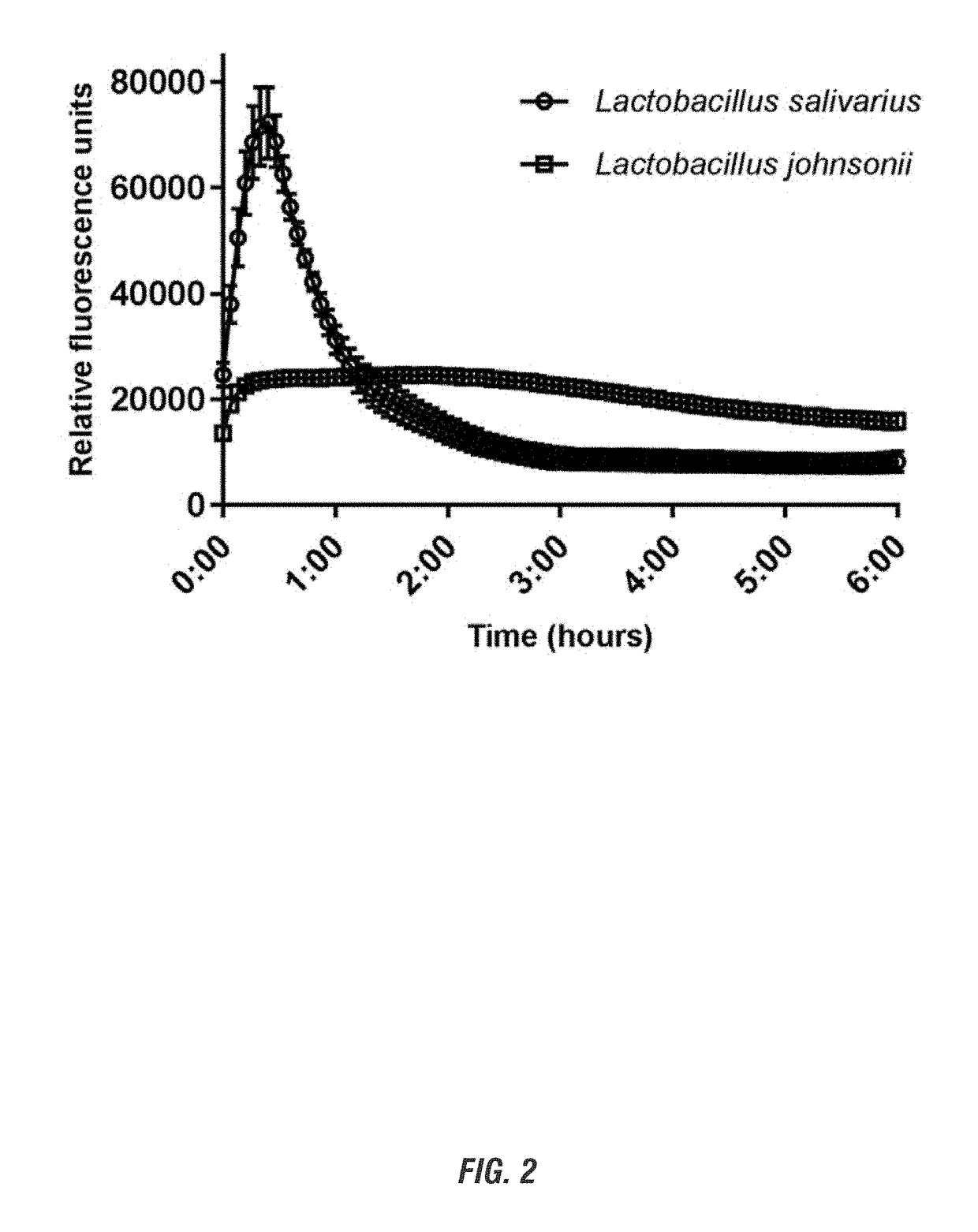Neurotransmitter transport in probiotics
a probiotic and neurotransmitter technology, applied in the field of neurotransmitter transport in probiotics, can solve the problems of inability to screen the large library of probiotics that exist, lack of understanding of the mechanism, etc., and achieve the effect of reducing the concentration of free biogenic amines and increasing fluorescen
- Summary
- Abstract
- Description
- Claims
- Application Information
AI Technical Summary
Benefits of technology
Problems solved by technology
Method used
Image
Examples
example 1
ation of PMAT-Like
[0083]To demonstrate the presence of at least one uptake2 system is present in the gut microbiome, the PMAT-like uptake was assessed in Lactobacillus strains.
[0084]A neurotransmitter transporter uptake assay kit system (Molecular Devices Kit #R6138, Sunnyvale, Calif.) was used. The kit was used according to the instructions with the exception of the identified solution (a basal salt solution, e.g. Hank's Balanced Salt Solution or HBSS) for culturing the cells. In this regard, the inventors have identified the use of HBSS with microbial samples is inoperable. Instead, a more complete medium, deMan, Rogosa and Sharpe (MRS), was used in its place. Other suitable solutions include, for example, phenol red free medium such as Iscove's Modified Dulbecco's Medium (IMDM) or Dulbecco's Modified Eagle Medium (DMEM). Furthermore, other suitable kits include Molecular Devices Kit #R8173 and #R8174. A range of probiotic strains was employed and examined with the kit. It should ...
example 2
ation of OCT-Like Capability
[0089]To determine if an additional uptake2 system was present in gut microbes, OCT-like capability was assayed in Lactobacillus strains.
[0090]The fluorophore ASP+[4-(4-(diethylamino)styryl)-N-methylpyridinium iodide] was obtained from Sigma Chemical Company (Sigma #D4318) and used as described in Duan et al., Drug Metabolism and Disposition, volume 43, pages 1773-1780, 2015 (herein incorporated by reference) with a slight modification in the ratio of ASP+ and Trypan blue used. To demonstrate specificity of the transport capability, a known OCT blocker, decynium-22 (D-22, Sigma, #323764) was employed.
[0091]It should be noted that none of the above chemicals or methods have ever been used with bacterial cells before to examine transport functionality related to biogenic amine uptake. Published reports utilizing such chemicals have been solely restricted to eukaryotic cells from mammals.
[0092]The approach utilized was the same as that described in Example 1...
example 3
of Probiotic Strains
[0098]In order to further show the importance of being able to screen specific strains of the gut microbiome, various strains of Lactobacilli were isolated from a variety of sources, including from a number of different animal species. The strains were screened to determine if they were positive or negative for either PMAT-like or OCT-like capabilities:
Genus / speciesLyte lab #OriginResults 1. L. reuteriML1004ATCC strainYES 2. L. reuteriML1013ATCC type strainYES 3. L. salivariusML1014UCC-118 probioticYES 4. L. crispatusML1018Porcine intestinal scrapingNO 5. L. salivariusML1019Porcine intestinal scrapingYES 6. L. reuteriML1020Porcine intestinal scrapingYES 7. L. reuteriML1022Porcine intestinal scrapingYES 8. L. salivariusML1031Monkey vaginal swabYES 9. L. murinusML1034Monkey vaginal swabNO10. L. salivariusML1036Monkey vaginal swabYES11. L. murinusML1038Monkey vaginal swabNO12. L. salivariusML1042ATCC type strainYES13. L. brevisML1043ATCC strainYES14. L. rhamnosusML1...
PUM
| Property | Measurement | Unit |
|---|---|---|
| time | aaaaa | aaaaa |
| time | aaaaa | aaaaa |
| time | aaaaa | aaaaa |
Abstract
Description
Claims
Application Information
 Login to View More
Login to View More - R&D
- Intellectual Property
- Life Sciences
- Materials
- Tech Scout
- Unparalleled Data Quality
- Higher Quality Content
- 60% Fewer Hallucinations
Browse by: Latest US Patents, China's latest patents, Technical Efficacy Thesaurus, Application Domain, Technology Topic, Popular Technical Reports.
© 2025 PatSnap. All rights reserved.Legal|Privacy policy|Modern Slavery Act Transparency Statement|Sitemap|About US| Contact US: help@patsnap.com



